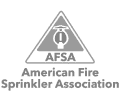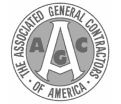Fire Sprinkler Head Location and Coverage
At Kauffman Co., we believe that an intelligently designed sprinkler system is the single most important thing you can have in your building to keep it safe from fires at all times. And the most important aspect of fire sprinkler installation is making sure your sprinkler heads are located in the proper places to provide the best coverage.
Sprinkler Head Location and Coverage
There are two main criteria for determining the location of sprinkler heads:
- Because fire sprinklers are heat activated, sprinkler heads must be located high up on or near the ceiling.
- Sprinkler heads must be unobstructed to provide maximum flow to the areas that need it. This means they cannot be blocked by beams, trusses, soffits, or any other elements of your building’s construction.
When properly installed, most sprinkler heads will have an 8’ coverage radius. This is one of many determining factors in how the sprinkler heads must be spaced.
Sprinkler Head Distance and Spacing Requirements
The NFPA lays out specific spacing requirements for sprinkler heads. These requirements are based on hazard level as well as pump flow calculations and may need to be adjusted based on any obstructions that may be present in the area of the sprinkler head.
| Hazard Level | Coverage (in sq ft) per Sprinkler Head | Maximum Allowed Distance Between Sprinkler Heads |
| Light Hazard (areas with low concentrations of flammable materials) | 130-200 sq ft per head | 15 ft |
| Ordinary Hazard 1 & 2 (areas with moderate concentrations of flammable materials) | 130 sq ft per head | 15 ft |
| Extra Hazard 1 & 2 (areas with a high concentration of flammable materials) | 90-130 sq ft per head (based on obstructions and flow calculations) | 12 ft |
Other sprinkler head spacing requirements include:
- Distance from walls: half the distance between sprinkler heads (i.e. 15’ between sprinkler heads, 7.5’ from walls)
- Minimum distance between sprinkler heads: usually 6’
- Distance from ceilings: minimum 1”, maximum 12”.*
* Most sprinkler heads will be installed 1″ from the ceiling. Concealed, recessed, or flush-mounted sprinkler heads may be listed for shorter distances.
TOP 5 REASONS FOR POOR SPRINKLER PERFORMANCE
Post-fire loss investigations reveal the cause of fires and causes associated with sprinkler system failures. Some common causes of unsatisfactory sprinkler system performance failures are failure to operate, ineffectiveness to control a fire and failure to limit damages to life and property. The top five reasons for poor sprinkler performance are:
- Water shut off
- A sprinkler system that is not designed for the proper hazard level
- Lack of adequate water supplies
- Inadequate sprinkler system maintenance
- Obstruction to the sprinkler system’s water distribution
TYPES OF FIRE SPRINKLERS
- PENDENT FIRE SPRINKLER HEADS – Pendent fire sprinkler heads protrude from the ceiling like a miniature pendant light fixture. Once water begins to flow from a pendent sprinkler head, it hits the deflector and sprays outward in a wide arch, providing the best coverage of any fire sprinkler head.
- UPRIGHT FIRE SPRINKLER HEADS – This style is best suited for commercial buildings with structures such as beams and ductwork that block the ceiling. As their name suggests, upright fire sprinkler heads stand upright. They are mounted on pipes so they face the ceiling. When heat from a fire activates them, water shoots upward and immediately deflects downward thanks to a concave deflector.
- SIDEWALL FIRE SPRINKLER HEADS – You might find sidewall fire sprinkler heads in small rooms, hallways, and other areas where the sprinkler plumbing system runs through the walls instead of the ceiling. Hotel rooms are the most common application for this fire sprinkler head style. Sidewall fire sprinkler heads protrude through the wall and have a unique deflector design that allows water to spray in a crescent or half-circle shape.
- CONCEALED FIRE SPRINKLER HEADS – Many people are put off by the appearance of fire sprinkler heads. They want fire protection, but not at the expense of aesthetics. Concealed fire sprinkler heads are the answer. These are similar to pendent sprinklers, but they’re installed higher in the ceiling and hidden behind a cover plate. When heat from a fire approaches about 20 degrees below the temperature that the fire sprinkler will activate, the cover plate falls off, exposing the glass bulb to the heat so the sprinkler can engage shortly thereafter.
Extended Coverage Sprinkler Heads
If your building needs more protection than you can get with a standard coverage fire sprinkler, or if heads cannot be installed to meet normal spacing requirements, you may need to install extended coverage sprinkler heads. These sprinkler heads have an increased radius of approximately 10 ft and can be spaces about 20 ft apart. At Kauffman Co., our fire sprinkler design engineers will take your specific building factors into consideration to install a fire protection system that will keep you safe at all times. If you need to install a fire sprinkler system in Houston, call Kauffman Co. today!















